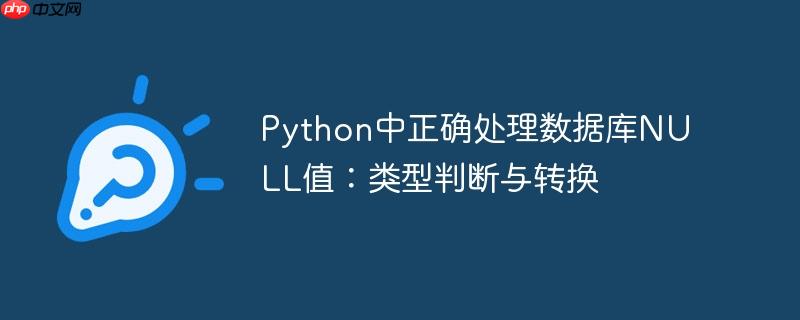
本文旨在解决Python处理从数据库读取的NULL值时遇到的类型判断和转换问题。通过分析常见的错误处理方式,并提供正确的代码示例,帮助开发者有效地将数据库中的NULL值转换为Python中合适的类型,例如空字符串或数值0,从而避免程序出错并保证数据的一致性。
在Python中,从数据库读取数据时,经常会遇到NULL值。NULL在数据库中表示缺失或未知的数据,而在Python中,它对应的是None对象。如果不正确处理None值,可能会导致程序抛出异常或产生意料之外的结果。本文将深入探讨如何有效地处理数据库中的NULL值,并将其转换为Python中合适的类型。
首先,需要明确None的类型。在Python中,None是NoneType类的唯一实例。
print(type(None))
输出:
立即学习“Python免费学习笔记(深入)”;
<class 'NoneType'>
这意味着,直接使用isinstance(item, (Decimal, float))来判断item是否为数值类型是不正确的,因为None既不是Decimal也不是float。
正确的处理方式是首先检查item是否为None,然后再根据需要进行类型转换。以下是一个改进后的format_item函数:
from decimal import Decimal
def format_item(item):
if item is None:
# 根据你的需求,选择返回空字符串或0.00
# return "" # 返回空字符串
return 0.00 # 返回 0.00
elif isinstance(item, (Decimal, float)):
return float(item)
else:
return str(item)在这个函数中,首先判断item是否为None。如果是,则根据你的需求返回空字符串或0.00。如果item不是None,则根据其类型进行相应的转换。
在你的stored_procedure_call函数中,可以这样使用format_item函数:
import mysql.connector
import os
import json
import logging
from dotenv import load_dotenv
# 假设 get_db_password 函数已定义
def stored_procedure_call(SP_name, id, entity):
logging.info(f"Fetching DB connection details.")
try:
# Load env file
load_dotenv()
# Create the connection object
conn = mysql.connector.connect(
user=os.getenv('USER_NAME'),
password=get_db_password(os.getenv('RDS_HOST')),
host=os.getenv('RDS_HOST'),
database=os.getenv('DB_NAME'),
port=os.getenv('PORT'))
# Create a cursor
cursor = conn.cursor()
except Exception as error:
logging.error("An unexpected error occurred: {}".format(error))
return {
'statusCode': 500,
'body': json.dumps(f"Database connection error: {error}")
}
try:
# Call the stored procedure with the provided ID
cursor.callproc(SP_name, [id, entity])
conn.commit()
result_list = []
for result in cursor.stored_results():
rows = result.fetchall()
for row in rows:
result_list.append(list(row))
logging.info(row)
if not result_list:
return {
'statusCode': 200,
'body': json.dumps([])
}
result_list_serializable = [list(format_item(item) for item in tup) for tup in result_list]
return {
'statusCode': 200,
'headers': {
'Content-Type': 'application/json'
},
'body': json.dumps(result_list_serializable)
}
except Exception as e:
logging.error(f"Error executing stored procedure: {e}")
return {
'statusCode': 500,
'body': json.dumps(f"Error executing stored procedure: {e}")
}
finally:
if conn:
cursor.close()
conn.close()
def format_item(item):
if item is None:
# 根据你的需求,选择返回空字符串或0.00
# return "" # 返回空字符串
return 0.00 # 返回 0.00
elif isinstance(item, (Decimal, float)):
return float(item)
else:
return str(item)
在这个修改后的代码中,format_item函数被用来处理从数据库读取的每个值,确保None值被正确地转换为指定的默认值。
正确处理数据库中的NULL值是编写健壮的Python应用程序的关键。通过首先检查None值,然后根据需要进行类型转换,可以避免程序出错并保证数据的一致性。同时,注意数据库连接管理、异常处理、类型转换和日志记录,可以提高程序的可靠性和可维护性。
以上就是Python中正确处理数据库NULL值:类型判断与转换的详细内容,更多请关注php中文网其它相关文章!

每个人都需要一台速度更快、更稳定的 PC。随着时间的推移,垃圾文件、旧注册表数据和不必要的后台进程会占用资源并降低性能。幸运的是,许多工具可以让 Windows 保持平稳运行。

Copyright 2014-2025 https://www.php.cn/ All Rights Reserved | php.cn | 湘ICP备2023035733号